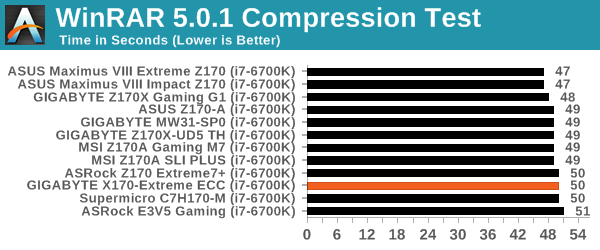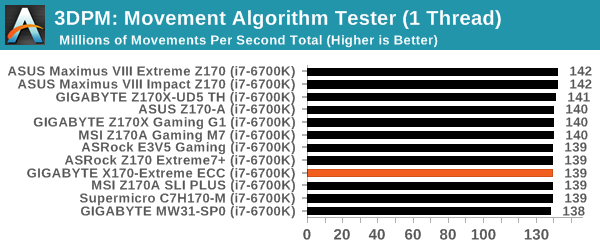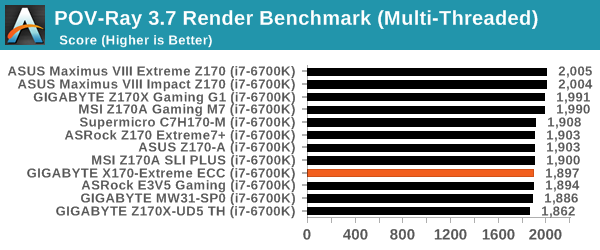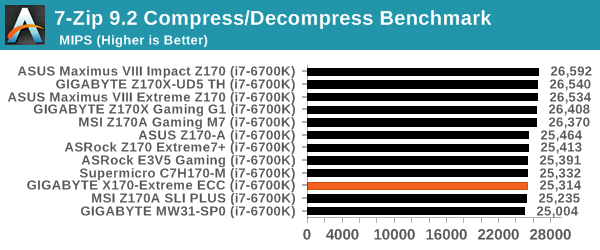The GIGABYTE X170-Extreme ECC Motherboard Review: For When Skylake Xeons need SLI and Thunderbolt 3
by Ian Cutress on October 17, 2016 2:00 PM ESTCPU Performance, Short Form
For our motherboard reviews, we use our short form testing method. These tests usually focus on if a motherboard is using MultiCore Turbo (the feature used to have maximum turbo on at all times, giving a frequency advantage), or if there are slight gains to be had from tweaking the firmware. We leave the BIOS settings at default and memory at JEDEC (DDR4-2133 C15) for these tests, making it very easy to see which motherboards have MCT enabled by default.
Video Conversion – Handbrake v0.9.9: link
Handbrake is a media conversion tool that was initially designed to help DVD ISOs and Video CDs into more common video formats. For HandBrake, we take two videos (a 2h20 640x266 DVD rip and a 10min double UHD 3840x4320 animation short) and convert them to x264 format in an MP4 container. Results are given in terms of the frames per second processed, and HandBrake uses as many threads as possible.


Compression – WinRAR 5.0.1: link
Our WinRAR test from 2013 is updated to the latest version of WinRAR at the start of 2014. We compress a set of 2867 files across 320 folders totaling 1.52 GB in size – 95% of these files are small typical website files, and the rest (90% of the size) are small 30 second 720p videos.

Point Calculations – 3D Movement Algorithm Test: link
3DPM is a self-penned benchmark, taking basic 3D movement algorithms used in Brownian Motion simulations and testing them for speed. High floating point performance, MHz and IPC wins in the single thread version, whereas the multithread version has to handle the threads and loves more cores. For a brief explanation of the platform agnostic coding behind this benchmark, see my forum post here.


Rendering – POV-Ray 3.7: link
The Persistence of Vision Ray Tracer, or POV-Ray, is a freeware package for as the name suggests, ray tracing. It is a pure renderer, rather than modeling software, but the latest beta version contains a handy benchmark for stressing all processing threads on a platform. We have been using this test in motherboard reviews to test memory stability at various CPU speeds to good effect – if it passes the test, the IMC in the CPU is stable for a given CPU speed. As a CPU test, it runs for approximately 2-3 minutes on high end platforms.

Synthetic – 7-Zip 9.2: link
As an open source compression tool, 7-Zip is a popular tool for making sets of files easier to handle and transfer. The software offers up its own benchmark, to which we report the result.











31 Comments
View All Comments
SetiroN - Monday, October 17, 2016 - link
There is only one thing that's worse than camo: pixelized camo.I honestly fail to understand who in the world would ever buy a socket 1150 Xeon solution instead of socket 2011.
dave_the_nerd - Monday, October 17, 2016 - link
1) Digital camo has been standard-issue in the military for a while now.2) Anybody who only needs a 4c/8t system, but is otherwise doing "workstation" or server-grade work. (Uptime requirements, longevity requirements, need ECC ram for data crunching, need virtualization features, etc.)
zepi - Monday, October 17, 2016 - link
4c/8t LGA2011 solution hardly costs much more, especially since this board is approaching the pricing of workstation mobos...Einy0 - Monday, October 17, 2016 - link
2) The supposed advantages are 95% marketing. Uptime is more about your OS if you select quality components to go with the CPU. Longevity, seriously??? I can show you desktops built 30+ years ago that run today the same as they did then. How many CPUs actually die? I personally have had one die, it was 7 years old. Virtualization, again no more features on the 1151 Xeon versus the i7. ECC, that's the one feature an 1151 Xeon has over a similar i7. Now when we start talking multi-socket and what not well that's obvious. I've had these conversations in the past with engineers and developers at work. Everyone just assumes that when Intel says they need a Xeon to do something there is a reason. Yup, there is a reason, they can make more money from the same chip with a Xeon badge on it.HollyDOL - Tuesday, October 18, 2016 - link
Yep, you can show 30 old desktops still working, but how many of them were running 24/7? None.mkaibear - Tuesday, October 18, 2016 - link
Up until very recently I had a desktop of about that vintage running SCO Unix. That ran 24/7. In fact we were scared to turn it off because it ran chunks of the factory...devol - Saturday, October 22, 2016 - link
There are more differences than just ECC memory. For instance i7 cpu's don't support hugetlb/hugepages, and several other 'server' focused virtualization extensions. Until Skylake though, the PCH had basically no support for needed features for SR-IOV.bigboxes - Monday, October 17, 2016 - link
I'm sorry. I can't see the motherboard. Where is it in the picture?stardude82 - Friday, November 18, 2016 - link
I think it's generally acknowledged now that the digital camouflage was a failure.https://en.wikipedia.org/wiki/MultiCam#United_Stat...
BrokenCrayons - Monday, October 17, 2016 - link
Yeah, it's really off-putting to see camo. I think they're going for some kind of military/tactical thing, but Gigabyte's failed to realize that camo just makes a product look trashy and redneck to people in the US these days.